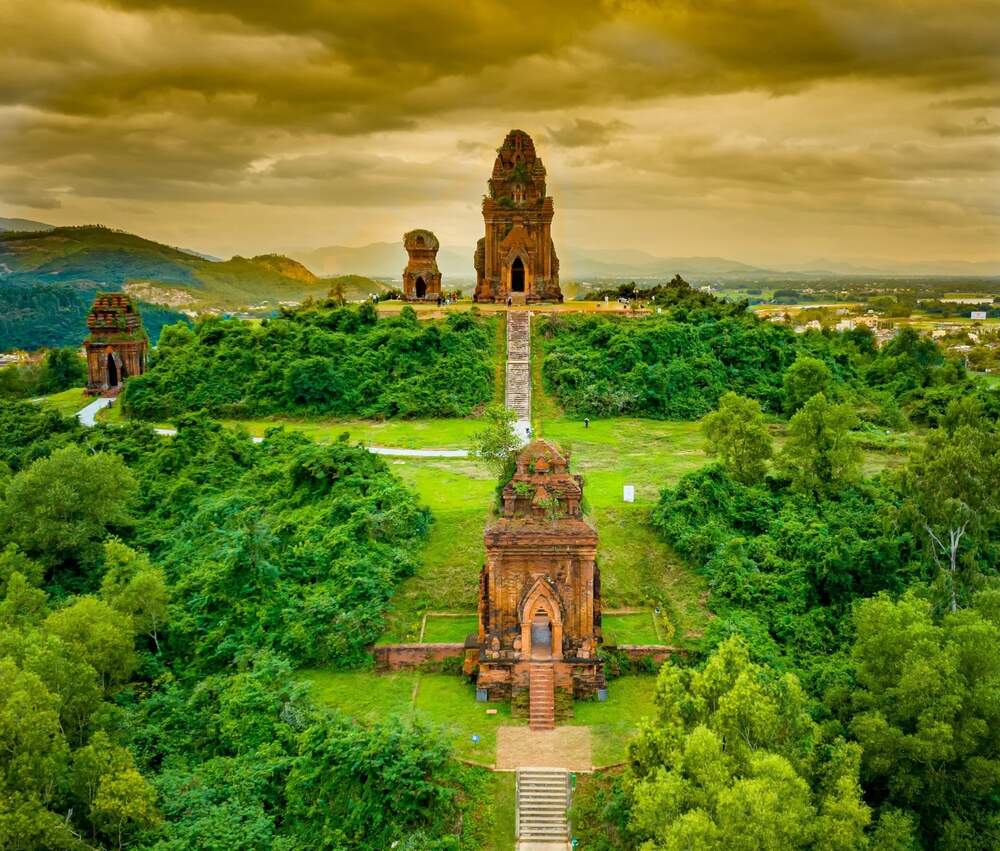The Bánh Ít Tower - Cultural Beauty of the Cham in Binh Dinh

The Bánh Ít Tower complex consists of four towers radiating in four directions and converging in the middle. The towers are constructed from dark red-fired bricks, featuring pyramid or lotus-shaped architectural designs. These towers serve religious and spiritual purposes, honoring Hindu deities like Shiva, Vishnu, and Buddhist figures such as Amitabha. Within the towers, small spaces are designated for altars or stone statues. Each tower has a single entrance facing east - the direction of the rising sun.
Throughout its history, the Bánh Ít Tower has endured damage from both natural disasters and human actions. In 1833, Emperor Minh Mang destroyed statues and inscriptions in the towers to eradicate Cham Pa's influence. In 1904, the French army excavated and looted numerous artifacts from the towers. In 1972, during the Vietnam War, the American military bombed and partially destroyed the towers. After gaining independence, Vietnam undertook conservation efforts and restoration of the towers. In 1991, the Bánh Ít Tower was recognized as a National Historical and Cultural Site.
Architecture of the Bánh Ít Tower
The Bánh Ít Tower boasts unique and refined architecture, reflecting a harmonious blend of Cham Pa and Indian architectural styles. The complex includes four main towers: the gate tower, the main tower, the southern tower, and the final tower.
The gate tower is situated on the eastern side of the complex, standing at 13 meters tall with two doorways facing east-west. The gate tower follows the Gopura style - a type of Hindu gate with a pointed arch and multiple stacked layers. It serves as the entrance to the tower complex and often houses inscriptions in Sanskrit or Cham.
The main tower is the largest and tallest in the complex, reaching a height of 22 meters with a square base of 10 meters on each side. Following the Kala style - a Hindu tower with a pointed roof and dragon head motifs at the corners, the main tower is dedicated to worshiping Shiva, the supreme Hindu deity. Inside the towers, a stone altar holds a linga, a symbol of Shiva.

The southern tower is situated on the southern side of the complex, standing at 20 meters tall with an 8-meter square base on each side. Following the Padma style - a Hindu tower with a lotus-shaped roof and lotus motifs at the corners, the southern tower is dedicated to worshiping Vishnu, the protective Hindu deity. Inside the tower, a stone altar holds a bronze statue of Vishnu.
The final tower is on the western side of the complex, standing 18 meters tall with a 6-meter square base on each side. Following the Padma style like the southern tower, the final tower, however, lacks statues or inscriptions inside. It is dedicated to worshiping Amitabha, the Buddha of Infinite Light.
The Bánh Ít Tower is an exceptional and aesthetically pleasing architectural masterpiece of Cham Pa. The towers not only serve as places of worship for the Cham people's deities and Buddhas but also symbolize the Cham culture in Binh Dinh.
Cultural Value of the Bánh Ít Tower
The Bánh Ít Tower is a culturally significant architectural structure, a testament to the development of ancient Cham Pa culture. It beautifully demonstrates the harmonious integration of architectural, sculptural, religious, and spiritual elements in Cham culture. The Bánh Ít Tower also preserves inscriptions in Sanskrit and Cham, providing valuable information about the history, culture, and society of Cham Pa. Additionally, the towers showcase the cultural exchange between the Cham and Vietnamese, as the towers not only worship Hindu deities but also honor Buddhist figures.
The Bánh Ít Tower is an attractive tourist destination for those who love exploring historical and cultural heritage. Here, visitors can admire the beauty of ancient towers, learn about Cham Pa culture, and feel the solemnity and sacredness of the place. The Bánh Ít Tower truly deserves to be recognized as a cultural beauty of the Cham in Binh Dinh

